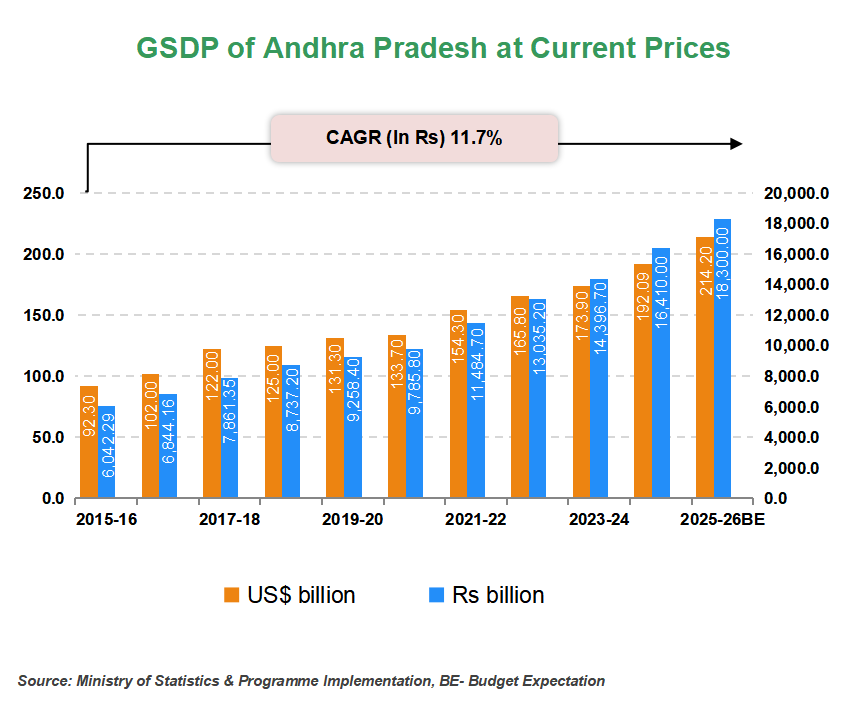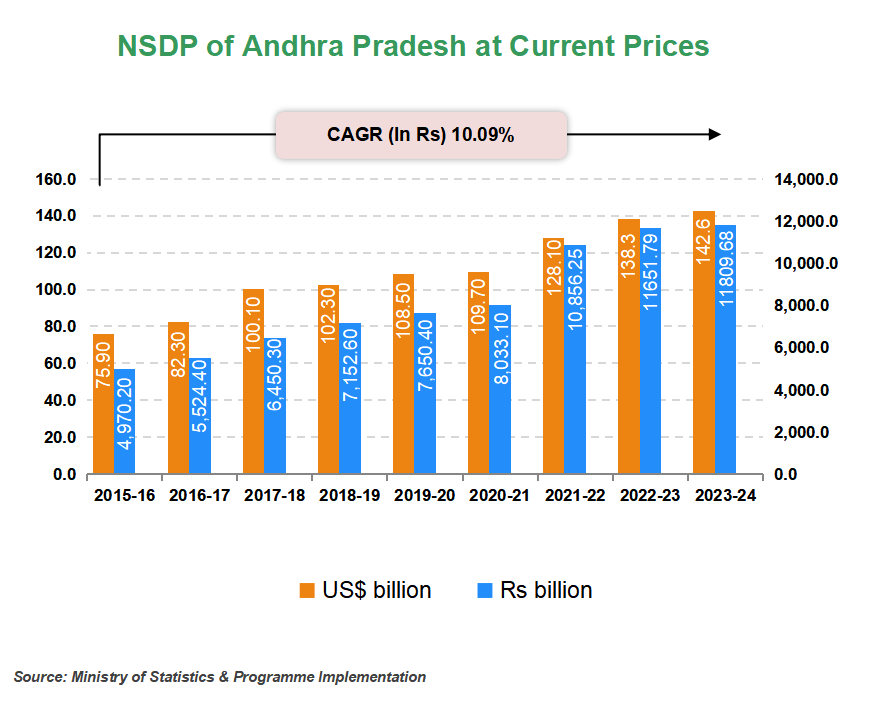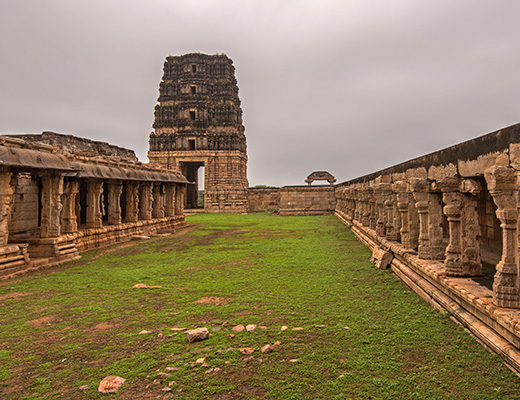Andhra Pradesh
In FY22, Andhra Pradesh ranked first in terms of marine exports from India with a 38% contribution to the US$ 7.74 billion worth of total marine exports.


Introduction

Andhra Pradesh (AP) is in the southern peninsula of India. The state shares its borders with Chhattisgarh on the north, Odisha on the northeast, Telangana and Karnataka on the west, Tamil Nadu on the south, and the Bay of Bengal on the east.
The erstwhile state of Andhra Pradesh has been bifurcated into two states, Telangana and residuary Andhra Pradesh (Seemandhra), by the Andhra Pradesh Reorganisation Act, 2014, or the Telangana Act. The Act consisted of the aspects of the division of assets and liabilities, the boundaries of the proposed new states, and the status of the capital city Hyderabad after the separation of the state.
It is the first state in the country to have enacted the Industrial Single Window Clearance. The Act made it compulsory for new industries to register with a single window to obtain clearances quickly. It also simplified procedures for getting industrial clearances. The state also has separate acts for development in sectors such as solar power, electronic hardware, and food processing.
With 26 districts and a geographical area of 1,62,970 sq. km., Andhra Pradesh ranks as the 8th largest state in the country. The state has a well-developed social, physical, and industrial infrastructure, as well as virtual connectivity. It also has good power, airport, IT, and port infrastructure. At current price, Andhra Pradesh's Gross State Domestic Product (GSDP) is expected to be Rs. 18,30,000 crore (US$ 214.20 billion) for FY26. The GSDP increased at a CAGR (in Rs.) of 11.7% between FY16 and FY26.
The government is striving towards creating quality infrastructure, coupled with a congenial industrial environment in the state, to make AP an attractive destination for both domestic and foreign investors.
According to Department for Promotion of Industry and Internal Trade (DPIIT), FDI inflow in Andhra Pradesh between October 2019-Dec 2024 stood at Rs. 9,397 crore (US$ 1.1 billion).
Merchandise exports from Andhra Pradesh increased to Rs. 1,59,242 crore (US$ 18.64 billion) in FY25 (Until Feb). Engineering Goods are the largest export category of the state, accounting for around 24.72% of the total exports in FY25 (Until Feb) and stood at 25.14% of total exports.
Andhra Pradesh has most of the power projects of undivided Andhra Pradesh. Coal-based power plants are mostly located in the state due to their proximity to the ports. As on March 2025, Andhra Pradesh has a total installed power generation capacity of 28,409.04 MW. Of the total, private utilities contributed 17,719.11 MW, state utilities contributed 8,576.38 MW and central utilities contributed 2,113.56 MW.
Recent Developments in Key Sectors
- Traffic handled by the Visakhapatnam port reached 82.62 million tonnes in FY25.
- As per budget estimates FY26:
- Education: Rs. 20,492 crore (US$ 2.40 billion) has been designated for teaching grants, while Rs. 2,335 crore (US$ 275.7 million) has been earmarked for the Samagra Shiksha initiative.
- Roads and bridges: Rs. 1,968 crore (US$ 230.4 million) allocated towards capital outlay on roads and bridges.
- Urban Development: Rs. 6,000 crore (US$ 702.3 million) allocated for Amaravati capital city development project.
- Rs. 4,000 crore (US$ 468.2 million) has been made for the Dr. Nandamuri Taraka Ramarao Vaidya Seva Trust, while Rs. 1,385 crore (US$ 162.1 million) has been designated for teaching hospitals.
- In July 2023, Union Minister for Road Transport and Highways, Mr. Nitin Gadkari, laid the foundation stone for three NH projects in Tirupati, Andhra Pradesh. These projects include the Naidupate-Turpu Kanupur Section of NH-71, spanning 35 km and requiring an investment of Rs. 1,399 crore (US$ 167.9 million), the Chillakuru Cross-Krishnapatnam Port South Gate Section via Turpu Kanupur on NH-516W, covering 36 km and valued at Rs. 909 crore (US$ 109.1 million), and the Thamminapatnam-Narikellapalle Section, which extends the Dedicated Port Road from Eupuru to Krishnapatnam Port on NH-516W and NH-67, with a length of 16 km and valued at Rs. 610 crore (US$ 73.2 million).
- In September 2022, Minister for Road Transport and Highways, Mr. Nitin Gadkari, laid the foundation stones for eight National Highway Projects worth Rs. 3,000 crore (US$ 367.45 million) in Rajamahendravaram, Andhra Pradesh.
The total R&B road network (excluding NH roads) in the state as on December 2022 was 45,321 kms, comprising 12,595.60 kms of state highways, and 26,485.51 kms of major district road and rural roads.
Under AP Mandal Connectivity and Rural Connectivity Improvement project (APMCRCIP), government proposed to improve roads and & bridges of major district roads/other district roads for a length of 728.59 km with Rs.1987.60 crore (US$ 239 million).
Under Major District Roads (MDR) 31 road works with a length of 174.77 km and 5 bridge works have been completed for an amount of Rs. 355.77 crore (US$ 42.8 million).
- The "Russian Education Fair 2022" was held on September 14, 15, and 16 in Visakhapatnam, Vijayawada, and Nellore, respectively, by the Russian Centre of Science and Culture (Cultural Department of the Russian Consulate in South India). This fair was conducted to help Indian students pursue UG and PG in medicine in Russia.
- Andhra Pradesh is home to many global and national pharma players, and various companies have set up their manufacturing hubs in different cities of the state. Pharmaceutical exports from the state stood at US$ 2,199.56 million in FY24.
- Hyderabad has become one of the preferred destinations for global pharma biotech investments and has attracted around Rs. 7,500 crore (US$ 983.52 million) of investments in FY22, which is expected to result in employment for about 35,000 people.
- Under the Ayushman Bharat Digital Mission (ABDM), Andhra Pradesh has become the first state in the nation to connect the electronic health records of one crore people to the central database.
- In November 2023, Andhra Pradesh Chief Minister Mr. Y S Jagan Mohan Reddy virtually inaugurated and laid the foundation for various power projects worth Rs. 6,600 crore (US$ 792.3 million). This includes 2 solar power projects in Kadapa and Anantapur valued at Rs. 3,400 crore (US$ 408.2 million), the foundation for 16 power substations costing Rs 2,479 crore (US$ 297.35 million), and the inauguration of 12 substations worth Rs. 620 crore (US$ 74.4 million).
- In March 2022, Arcelor Mittal announced a renewable energy partnership with Greenko Group with an investment of US$ 600 million to own and fund a 975 MW renewable energy project in Andhra Pradesh.
- The Andhra Pradesh Industrial Infrastructure Corporation Limited (APIIC) is preparing to offer all of its services online in the near future. This will minimise the necessity for in-person meetings between the concerned entrepreneurs and officers. Additionally, it is creating a mobile application to make the services accessible on the go.
- The presence of rich climatic and soil conditions makes Andhra Pradesh a major agricultural belt. Few of the leading crops produced in the state include rice, chilly, oilseeds, cotton, pulses, and grams.
- 77 agri testing labs were operationalised from the Kharif 2022 season to address the problem of spurious seeds, fertilisers, and pesticides.
- The cost of installing electricity meters for agricultural pump sets would be borne by the state government.
- 52.38 lakh farmers received Rs. 7,016 crore (US$ 920 million) in financial assistance under the Rythu Bharosa scheme in 2021-22.
- Andhra Pradesh is home to a thriving fisheries industry and employs about 1.45 million people and contributes a major proportion to the total value of sea food export from the country.
- In FY24, marine products exports from the state stood at about US$ 2.96 billion.
- Andhra Pradesh is one of the largest producers of brackish water shrimps and freshwater prawns.
- In August 2021, Adani Ports announced that the proposal to acquire a 10.4% share in the Gangavaram Port (GPL) has been approved by the Andhra Pradesh government. The proposed acquisition will cost Rs. 644.78 crore (US$ 86.98 million).
- In September 2021, the Adani group announced it had completed the acquisition of Gangavaram port in the Visakhapatnam district of Andhra Pradesh for a total of Rs 6,200 crore (US$ 744.5 million).




